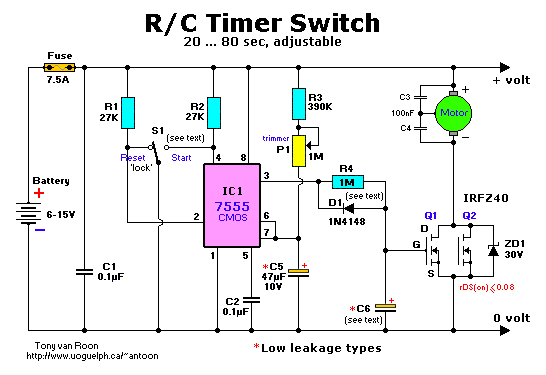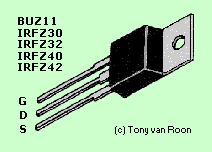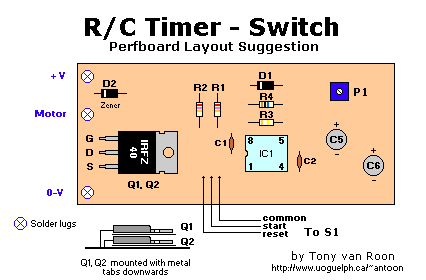

R1,R2 = 27K  R3 = 390K
R4 = 1M
P1 = 1M, trimmer
C1,C2,C3,C4 = 0.1uF (100nF)
C5 = 47uF/10V, low-leakage electrolytic
C6 = (optional)
D1 = 1N4148, 1N914, or equivalent
ZD1 = Zener Diode, 30V
IC1 = 7555 CMOS Timer
Q1,Q2 = BUZ11 MOSFET, or equivalent
S1 = on-off-on switch (see text)
Fuse = 7.5A
R3 = 390K
R4 = 1M
P1 = 1M, trimmer
C1,C2,C3,C4 = 0.1uF (100nF)
C5 = 47uF/10V, low-leakage electrolytic
C6 = (optional)
D1 = 1N4148, 1N914, or equivalent
ZD1 = Zener Diode, 30V
IC1 = 7555 CMOS Timer
Q1,Q2 = BUZ11 MOSFET, or equivalent
S1 = on-off-on switch (see text)
Fuse = 7.5A
Parts Description: As stated in the parts list above the 1/8 watt
resistors are of sufficient wattage to do the job. Final Word: Once you flip the switch to 'Start' and let go of the aircraft you have very little
control. It is imperative to fit a fuse to prevent burn-outs of the electric motor, battery, or plane if the
thing noses in and the prop stalls. The 7.5 amp flat automotive fuse is suitable for most applications using the
Speed 400. Adjust the fuse to a higher value if you use a Speed 600 or better motor.
Final Word: Once you flip the switch to 'Start' and let go of the aircraft you have very little
control. It is imperative to fit a fuse to prevent burn-outs of the electric motor, battery, or plane if the
thing noses in and the prop stalls. The 7.5 amp flat automotive fuse is suitable for most applications using the
Speed 400. Adjust the fuse to a higher value if you use a Speed 600 or better motor.